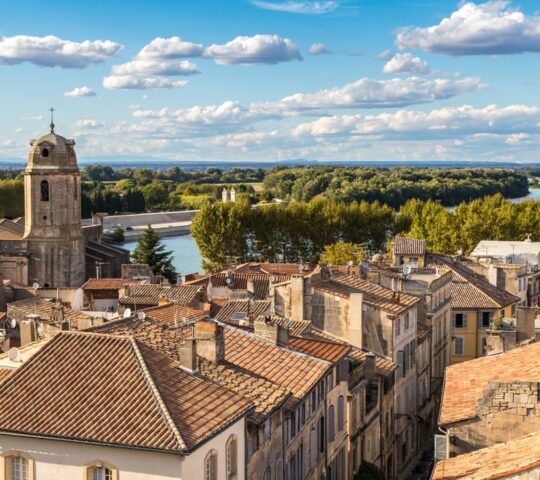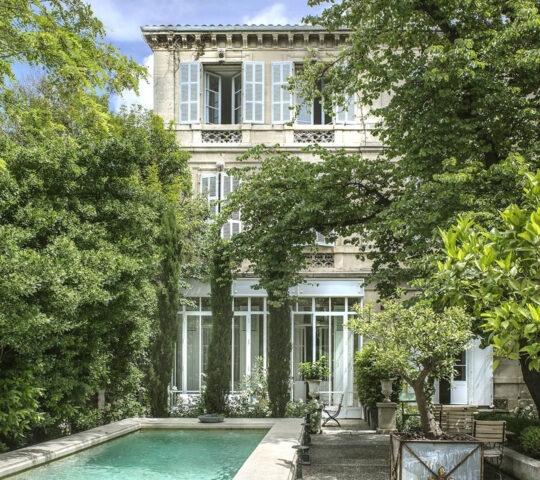- Days 1–3Crillon Le Brave
- Days 3–6Arles
- Days 6–9Aix en Provence
- Days 1–3Crillon Le Brave
- Days 3–6Arles
- Days 6–9Aix en Provence
Exploring Provence
From east to west, Provence is an idyllic part of France with so much to offer – from cobbled, ivy-lined streets in medieval villages, to ancient Roman architecture and delectable food. This wonderful trip will introduce you to everything that makes this region so special.
Trip highlights
- Discover the delights of a local Provençal market
- Spot pink flamingoes in the Camargue
- Enjoy a cooking class in a local chef's home
- Taste the powerful wines of Châteauneuf-du-Pape
- Explore Roman ruins on a privately guided of Arles
- Take a boat trip along the Mediterranean coast
Bespoke trips with Jacada
We design one-of-a-kind journeys incorporating luxury in all its forms. Our bespoke trips include:
- Luxury accommodation throughout
- Privately guided tours
- Private transfers
- Meticulously selected experiences
- Expertise and support from your Jacada Concierge

Itinerary in detail
Every Jacada trip is tailored to your personal preferences and interests. Below you’ll find a sample itinerary to inspire your own custom-designed journey.
Days 1–3
Village charm in Crillon Le Brave
Your journey through Provence begins in Crillon le Brave, a charming village dating back to the 17th century, where eight buildings now make up the beautiful Hotel Crillon Le Brave.
From here you’ll explore some of the surrounding countryside. In the Alpilles, an extension of the Luberon Mountains, steep slopes enable the growing of almonds, apricots, olives and grains. In the beautiful town of Avignon, you’ll explore centuries of history and visit its famous arched bridge.
You will also visit the UNESCO World Heritage-listed Pont du Gard, part of a Roman aqueduct, and take a trip to the Châteauneuf-du-Pape vineyards, before admiring the view of the lavender fields from the village of Sault.

Make it mine
Churches and chapels
Historic village
Stone fortress

Avignon tour
Avignon was, for some time, the capital of Christendom in the Middle Ages. It retains the indelible mark of its grandiose destiny: the Palais des Papes (Papal Palace), and the Saint-Benezet bridge called the “Pont d’Avignon”. It was the inspiration for the French song “Sur le Pont d’Avignon”. The surviving arches of the bridge, as well as the Palais des Papes and Cathédrale Notre-Dame des Doms, are listed by UNESCO as World Heritage sites. In addition, dozens of churches and chapels are all remains of a past rich in history.

Explore Saint Rémy
Surrounded by lush green perfumed valleys, the ancient streets of Saint Rémy are lined with beautifully restored old houses. While strolling through the narrow winding streets you will discover old fountains, shady squares, picturesque restaurants and elegant boutiques. This historic village is built on one of the oldest archaeological sites in Europe, and you will be able to explore the remains of the Comptoir de Glanum which was founded in the 2rd century BC.

Les Baux-de-Provence
Continue your exploration of the Alpilles passing through a sea of olive trees and vineyards to the village of Les Baux de Provence. Perched on a rocky plateau 245m high, this immense stone fortress is one of the must-sees in Provence and the village is officially classified as one of the most beautiful villages in France. You’ll also make a stop in Saint Paul de Mausole, where Vincent van Gogh was treated for a year. You will see the wheat field that the artist painted as well as a reproduction of the room where he was confined.
See the sights
Roman history
Wine tasting
Lavender fields

The Pont du Gard
Integrated into a natural site that has preserved its untamed charm, The Pont du Gard has been listed by UNESCO as a World Heritage Site since 1985. Two thousand years after its construction, this ancient edifice is still a veritable masterpiece, as much for the technical prowess involved, as for its simple beauty. The Pont du Gard made up part of the Roman aqueduct that brought water from Uzès to Nimes.

Châteauneuf-du-Pape wine tour
Between Avignon and Orange, Châteauneuf-du-Pape vineyards dominate the plain. The village, clustered at the foot of a 14th-century castle, is dotted with wine cellars that offer the best way to discover this rich and complex wine. This is where the AOC (appellation d’origine contrôlée) concept was born: measures of quality that, when adopted in 1923, bestowed on Châteauneuf the status of a high-quality wine when it became one of the first AOCs in 1936.

Sault lavender fields
Visit the village of Sault from where you will have a unique view of the lavender fields (in season). Situated on the border of a great wooded plateau, blooming with lavender, Sault is a health resort perched at 776m. All around the town lie immense blue fields alternating with fields of wheat for as far as you can see. While you are in the town, take time to enjoy the local food specialities such as nougat and lavender honey, or sit on the terrace of a local café as you blend in with the local population.
Days 3–6
Exploring historic Arles
In the historic city of Arles, you’ll head out on foot to see some of fascinating Roman monuments. The city was a major Roman centre, founded in 45 BC, and buildings including a remarkable amphitheatre still stand today.
The city also has a link to Van Gogh, and you’ll learn more about the famous painter and some of his most popular works he completed while living here.
Heading out from Arles, set off on a 4X4 safari in the Camargue to spot the horses and bulls that roam the marshlands.

The city and beyond
Sightseeing
The Camargue
Local flavours

Arles walking tour
If you love Roman monuments, this tour is for you. The amphitheatre, the 20th largest Roman amphitheatre in the world, is a highlight, now restored it to how it was during Roman times. You’ll also learn more about the painter Van Gogh who spent a year and a half in Arles. It’s here that he painted the Sunflowers and his Self-Portrait with Bandaged Ear. All over town, you will see reproductions of his paintings in front of the real sites, such as the yellow café of Café Terrace at Night.

A 4X4 safari
The Camargue, a captivating area in the Rhone Delta is home to a wide variety of wondrous flora and fauna. On this safari you will have the opportunity to see the bulls and horses that roam the extensive marshlands and are only found in the Camargue. Explore the lagoons and marshes and spot pink flamingoes and flocks of wild birds.

Maubec market and cooking class
Visit the charming village of Maubec where you will meet chef Jean-Marc Villard and his wife Alice. Together, you will head to the local Provençal market where the chef will help you select the perfect ingredients for your lunch. You will then go back to his house where you’ll prepare, and sit down to enjoy, a meal consisting of two amuse-bouches, a starter, main course and dessert.
Days 6–9
Art and culture in Aix
Aix-en-Provence is a city of art, light and activity. At its centre, the old town is ringed by a circle of boulevards and squares. It’s small enough to explore by foot and once you’re settled, your private guide will take you on a tour.
You’ll follow in the footsteps of the artist Cézanne, and take in some of the oldest parts of the medieval city along the way. Medieval Aix was protected by a wall with 39 towers, but today only the 14th-century “Tourreluquo” tower remains. On Cours Mirabeau, a beautiful tree-lined avenue, stroll past wonderful terrace cafés and bookshops, enjoying the atmosphere as you watch city life pass by. You can also visit the market, the Granet Museum and the atelier where Cézanne painted some of his most famous works.
Outside the city, visit a local market in the charming village of Maubec where you will select ingredients to use in an afternoon cooking class. Then it’s on to the seaside town of Cassis and its spectacular coastline, as well as Bandol, one of Provence’s most internationally recognised wine regions.

Heading south
Coastal exploration
Vineyard visits

Cassis and the Calanques
Together with your private guide, head to the town of Cassis. This little seaside resort is snuggled at the foot of a tall cliff called Cap Canaille. It’s a wonderful place to stroll, with its picturesque fishing port lined with cafes and restaurants. The town has lovely old quarters with a shady square where locals cool off and play pétanque on summer nights. You will also discover the Calanques by boat, a series of limestone cliffs, fjords and rocky promontories plunging into the Mediterranean.

Bandol
A visit to Bandol takes you to one of Provence’s most internationally recognised wine regions. Based around the fishing village of Bandol, west of Toulon, the Bandol AOC (Appelation d’origine controlee) covers the production of eight communes with silicon and limestone soils.


















